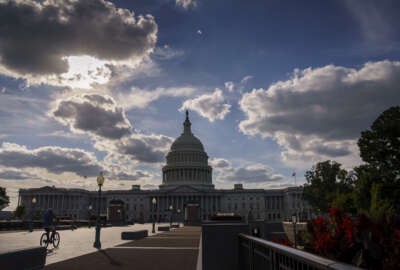

The government shutdown deadline is right around the corner. The good news? Congress has learned a few things from the last shutdown, bringing the tiniest bit of...
It’s never a great sign when, seven days before an upcoming government shutdown deadline, the Office of Management and Budget ever-so-calmly tells agencies that “prudent management” requires them to plan for a possible lapse in appropriations.
We’ve been down this road before.
No one wants to see it happen. Yet as I write this, it’s not immediately clear what path Congress will take to avoid a government shutdown before the upcoming deadline on Thursday at 11:59 p.m.
The Biden administration has said there is plenty of time for Congress to avoid a lapse in appropriations, which is true.
I’ll state the obvious: Government shutdowns aren’t good news for anyone.
One during a pandemic would be extra terrible. Yes, health care workers at the Department of Veterans Affairs, airport screeners at the Transportation Security Administration and border patrol agents would continue to work — without pay.
Large swaths of the Department of Health and Human Services would also likely keep working, again, without pay. But there’s nothing good about a government shutdown. It’s expensive, time consuming and stressful.
During the pandemic, jobs in the federal government have stood firm during the economic turmoil as a point of relative stability. Now? Well, we’ll see.
The last lapse in appropriations happened back in 2018-2019, and it impacted about 800,000 federal employees. At the time, Congress had funded some agencies, including the Defense Department. But dozens of others were unfunded by the December deadline, and they sent their employees home on furlough or into the office without pay.
This time, Congress hasn’t passed any of the appropriations bills necessary to fund the vast majority of federal agencies. A government shutdown in the next few days would impact nearly all agencies, including the military.
There are, of course, some exceptions. Some pockets of the federal government operate using fees or other funds that don’t come from annual appropriations. Those organizations may be spared.
According to the Partnership for Public Service, there have been 21 government shutdowns lasting a day or longer since the Carter administration.
The last partial government shutdown dragged on for 35 days, the longest in US history.
Federal employees visited food banks. They set up GoFundMe pages online.
In a set of guidance that, to put it mildly, didn’t sit well with most, the Office of Personnel Management suggested feds work with their personal attorneys or offer up their painting or carpentry services in exchange for partial rent payments.
Most of the military wasn’t impacted by the last partial shutdown, except for the often-forgotten Coast Guard. The commandant left exasperated video messages to his workforce, apologizing for a situation he called “unacceptable” and yet out of his control.
The last government shutdown was so bad, it forced to Congress to change a few laws. None that would actually prevent a shutdown from happening in the first place; that would be too wise.
But the changes do bring some much-needed certainty to federal employees the next time the government closes.
First, you will get paid.
We always say it during past government shutdowns, but it’s a guarantee now.
During the last debacle, former President Trump signed the Government Employee Fair Treatment Act into law, which guaranteed back pay to furloughed and excepted federal workers impacted by the 2018-2019 partial shutdown — and any subsequent lapse in appropriations that followed.
The law also clarifies that impacted employees receive retroactive pay “at the earliest date possible after the lapse in appropriations ends, regardless of scheduled pay dates.” That means that as soon a shutdown ends, payroll providers are supposed to get to work processing retroactive back pay to impacted feds, instead of simply waiting until the next scheduled paycheck.
The good news is that whenever the government closes next, Congress doesn’t need to spend extra time hashing out the details of a separate bill to give feds back pay. It’s already taken care of; Congress just needs to, you know, reopen the government.
Obviously it’s still not an ideal situation. Depending on the length of future government shutdowns, excepted federal workers could miss a paycheck — feds during the last one missed two! — and they won’t receive their back pay until the lapse in appropriations ends.
But the law does provide some clarity to a highly uncertain situation.
Second, federal employees shouldn’t see many big disruptions to their health insurance during future shutdowns.
Congress made certain federal health and life insurance services “essential” in a recent defense policy bill, and OPM has been implementing those changes over the last year.
This means employees will be allowed to enroll or make enrollment changes in the Federal Employees Health Benefits Program (FEHBP) and Federal Employees’ Group Life Insurance (FEGLI) Program during future lapses in appropriations.
Previously, furloughed employees or those working without pay during past government shutdowns couldn’t make enrollment changes to the FEHB because they were placed in “non-pay” status.
Some had trouble enrolling new dependents during the last partial shutdown, because the federal employees who would otherwise execute those changes were, in some cases, furloughed.
That should change next time there’s a government shutdown — whether it’s in a couple days or a couple years.
As for the upcoming deadline, well, there’s not much to do but plan for the possibility and wait.
See you on the other side.
A recording in the Nixon Presidential Library was rediscovered in 1997 wherein Richard Nixon reflects that, had rap music been popular when he was young, he might have become a rapper rather than a politician.
Source: Mental Floss
Copyright © 2025 Federal News Network. All rights reserved. This website is not intended for users located within the European Economic Area.
Nicole Ogrysko is a reporter for Federal News Network focusing on the federal workforce and federal pay and benefits.
Follow @nogryskoWFED

